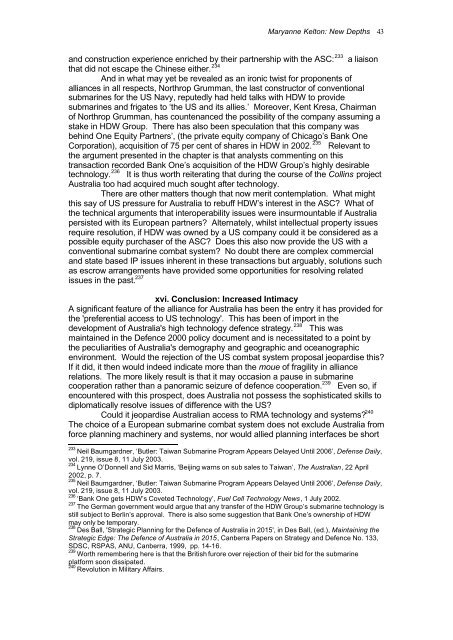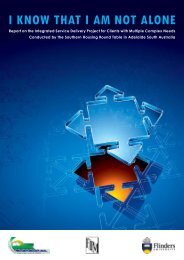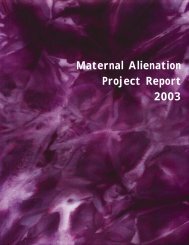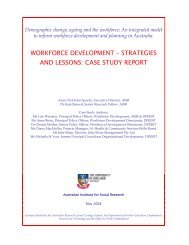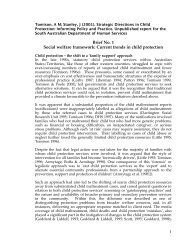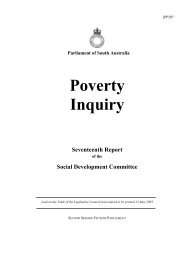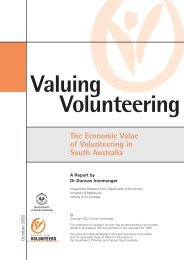New Depths in Australia-US Relations: The Collins Class ...
New Depths in Australia-US Relations: The Collins Class ...
New Depths in Australia-US Relations: The Collins Class ...
Create successful ePaper yourself
Turn your PDF publications into a flip-book with our unique Google optimized e-Paper software.
Maryanne Kelton: <strong>New</strong> <strong>Depths</strong> 43and construction experience enriched by their partnership with the ASC: 233 a liaisonthat did not escape the Ch<strong>in</strong>ese either. 234And <strong>in</strong> what may yet be revealed as an ironic twist for proponents ofalliances <strong>in</strong> all respects, Northrop Grumman, the last constructor of conventionalsubmar<strong>in</strong>es for the <strong>US</strong> Navy, reputedly had held talks with HDW to providesubmar<strong>in</strong>es and frigates to ‘the <strong>US</strong> and its allies.’ Moreover, Kent Kresa, Chairmanof Northrop Grumman, has countenanced the possibility of the company assum<strong>in</strong>g astake <strong>in</strong> HDW Group. <strong>The</strong>re has also been speculation that this company wasbeh<strong>in</strong>d One Equity Partners’, (the private equity company of Chicago’s Bank OneCorporation), acquisition of 75 per cent of shares <strong>in</strong> HDW <strong>in</strong> 2002. 235 Relevant tothe argument presented <strong>in</strong> the chapter is that analysts comment<strong>in</strong>g on thistransaction recorded Bank One’s acquisition of the HDW Group’s highly desirabletechnology. 236 It is thus worth reiterat<strong>in</strong>g that dur<strong>in</strong>g the course of the Coll<strong>in</strong>s project<strong>Australia</strong> too had acquired much sought after technology.<strong>The</strong>re are other matters though that now merit contemplation. What mightthis say of <strong>US</strong> pressure for <strong>Australia</strong> to rebuff HDW’s <strong>in</strong>terest <strong>in</strong> the ASC? What ofthe technical arguments that <strong>in</strong>teroperability issues were <strong>in</strong>surmountable if <strong>Australia</strong>persisted with its European partners? Alternately, whilst <strong>in</strong>tellectual property issuesrequire resolution, if HDW was owned by a <strong>US</strong> company could it be considered as apossible equity purchaser of the ASC? Does this also now provide the <strong>US</strong> with aconventional submar<strong>in</strong>e combat system? No doubt there are complex commercialand state based IP issues <strong>in</strong>herent <strong>in</strong> these transactions but arguably, solutions suchas escrow arrangements have provided some opportunities for resolv<strong>in</strong>g relatedissues <strong>in</strong> the past. 237xvi. Conclusion: Increased IntimacyA significant feature of the alliance for <strong>Australia</strong> has been the entry it has provided forthe 'preferential access to <strong>US</strong> technology'. This has been of import <strong>in</strong> thedevelopment of <strong>Australia</strong>'s high technology defence strategy. 238 This wasma<strong>in</strong>ta<strong>in</strong>ed <strong>in</strong> the Defence 2000 policy document and is necessitated to a po<strong>in</strong>t bythe peculiarities of <strong>Australia</strong>'s demography and geographic and oceanographicenvironment. Would the rejection of the <strong>US</strong> combat system proposal jeopardise this?If it did, it then would <strong>in</strong>deed <strong>in</strong>dicate more than the moue of fragility <strong>in</strong> alliancerelations. <strong>The</strong> more likely result is that it may occasion a pause <strong>in</strong> submar<strong>in</strong>ecooperation rather than a panoramic seizure of defence cooperation. 239 Even so, ifencountered with this prospect, does <strong>Australia</strong> not possess the sophisticated skills todiplomatically resolve issues of difference with the <strong>US</strong>?Could it jeopardise <strong>Australia</strong>n access to RMA technology and systems? 240<strong>The</strong> choice of a European submar<strong>in</strong>e combat system does not exclude <strong>Australia</strong> fromforce plann<strong>in</strong>g mach<strong>in</strong>ery and systems, nor would allied plann<strong>in</strong>g <strong>in</strong>terfaces be short233 Neil Baumgardner, ‘Butler: Taiwan Submar<strong>in</strong>e Program Appears Delayed Until 2006’, Defense Daily,vol. 219, issue 8, 11 July 2003.234 Lynne O’Donnell and Sid Marris, ‘Beij<strong>in</strong>g warns on sub sales to Taiwan’, <strong>The</strong> <strong>Australia</strong>n, 22 April2002, p. 7.235 Neil Baumgardner, ‘Butler: Taiwan Submar<strong>in</strong>e Program Appears Delayed Until 2006’, Defense Daily,vol. 219, issue 8, 11 July 2003.236 ‘Bank One gets HDW’s Coveted Technology’, Fuel Cell Technology <strong>New</strong>s, 1 July 2002.237 <strong>The</strong> German government would argue that any transfer of the HDW Group’s submar<strong>in</strong>e technology isstill subject to Berl<strong>in</strong>’s approval. <strong>The</strong>re is also some suggestion that Bank One’s ownership of HDWmay only be temporary.238 Des Ball, 'Strategic Plann<strong>in</strong>g for the Defence of <strong>Australia</strong> <strong>in</strong> 2015', <strong>in</strong> Des Ball, (ed.), Ma<strong>in</strong>ta<strong>in</strong><strong>in</strong>g theStrategic Edge: <strong>The</strong> Defence of <strong>Australia</strong> <strong>in</strong> 2015, Canberra Papers on Strategy and Defence No. 133,SDSC, RSPAS, ANU, Canberra, 1999, pp. 14-16.239 Worth remember<strong>in</strong>g here is that the British furore over rejection of their bid for the submar<strong>in</strong>eplatform soon dissipated.240 Revolution <strong>in</strong> Military Affairs.


